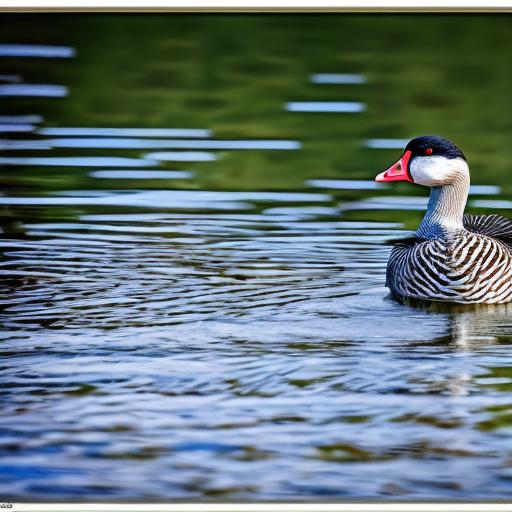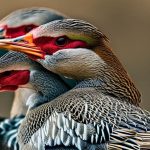Geese are known for their strong flocking instinct and their preference for open areas near water. They are attracted to well-maintained lawns, golf courses, and parks where they can find ample food and water sources. Geese are also known to be territorial and can become aggressive when they feel threatened or when they are protecting their nests and young. Understanding the behavior of geese is crucial in developing effective strategies for managing their presence.
Geese are social birds that prefer to stay in groups, and they are known to return to the same nesting and feeding areas year after year. They are also creatures of habit and can become accustomed to certain environments, making it difficult to deter them once they have established a presence. By understanding these behaviors, property owners can better anticipate and address potential issues with geese on their property.
Key Takeaways
- Geese are territorial and protective of their nesting areas, so understanding their behavior is crucial in deterring them.
- Implementing physical barriers such as fences or netting can effectively prevent geese from accessing certain areas.
- Using repellents and deterrents like taste aversions or visual deterrents can discourage geese from staying in an area.
- Creating a distraction with decoys like fake predators or other animals can help to scare geese away from a specific location.
- Utilizing sound and motion devices such as noise makers or moving objects can effectively scare geese away from an area.
- Consistent maintenance and monitoring of deterrent methods is important to ensure their effectiveness over time.
- Seeking professional assistance from wildlife control experts may be necessary for persistent geese problems that cannot be resolved with DIY methods.
Implementing physical barriers
One effective way to manage geese on a property is by implementing physical barriers that prevent them from accessing certain areas. This can include installing fences, hedges, or other structures that create a physical barrier between the geese and the areas they are attracted to. By limiting their access to food and water sources, property owners can discourage geese from frequenting their property.
Physical barriers can also be used to protect specific areas from geese, such as gardens, ponds, or recreational areas. By creating barriers that prevent geese from accessing these spaces, property owners can minimize the damage caused by their presence. It’s important to note that physical barriers should be carefully designed and installed to ensure they are effective and do not harm the geese or other wildlife.
Using repellents and deterrents
Another approach to managing geese is by using repellents and deterrents that make the environment less attractive to them. There are various commercial repellents available that can be applied to grass, plants, or other surfaces to discourage geese from feeding in those areas. These repellents often contain natural ingredients that are safe for the environment and other wildlife.
In addition to repellents, there are also deterrents that use visual or auditory cues to scare geese away. This can include reflective tape, scarecrows, or predator decoys that create the illusion of danger and make geese feel unsafe. By using a combination of repellents and deterrents, property owners can create an environment that is less appealing to geese and encourage them to seek food and shelter elsewhere.
Creating a distraction with decoys
Decoys can be an effective tool for managing geese by creating a distraction that draws them away from specific areas. Predator decoys, such as fake coyotes or birds of prey, can be strategically placed in areas where geese are known to congregate. The presence of these decoys can create a sense of danger for the geese, prompting them to avoid those areas in favor of safer locations.
In addition to predator decoys, there are also decoys that mimic the appearance of other geese. By placing these decoys in strategic locations, property owners can create the illusion of a larger flock, which may discourage geese from settling in those areas. Decoys can be an effective and non-invasive way to manage geese on a property without causing harm to the birds or the environment.
Utilizing sound and motion to scare geese away
Sound and motion can also be used as effective tools for scaring geese away from a property. There are various devices available that emit loud noises or use motion-activated features to startle geese and encourage them to leave the area. These devices can be strategically placed in areas where geese are known to congregate, such as near ponds or open fields.
In addition to commercial devices, property owners can also use natural methods to create sound and motion that deters geese. This can include using noisemakers, such as bells or horns, or employing trained dogs to patrol the property and discourage geese from settling in certain areas. By utilizing sound and motion as deterrents, property owners can effectively manage the presence of geese without causing harm to the birds or the environment.
Consistent maintenance and monitoring

Consistent maintenance and monitoring of a property are essential for managing the presence of geese. This includes regularly inspecting the property for signs of goose activity, such as droppings or feathers, and addressing any potential attractants, such as food sources or standing water. By maintaining a clean and well-kept environment, property owners can reduce the likelihood of geese settling on their property.
In addition to maintenance, it’s important to monitor the effectiveness of any deterrents or repellents that have been implemented. Property owners should regularly assess whether these strategies are deterring geese effectively and make adjustments as needed. By consistently maintaining and monitoring the property, property owners can proactively manage the presence of geese and minimize any potential issues.
Seeking professional assistance if necessary
In some cases, managing the presence of geese may require professional assistance. There are wildlife management companies that specialize in developing and implementing strategies for managing geese on residential and commercial properties. These professionals can conduct site assessments, develop customized management plans, and provide ongoing support to ensure that properties remain free from unwanted goose activity.
Professional assistance may also be necessary if property owners encounter challenges in managing geese on their own. This can include situations where geese have become aggressive or where their presence poses a threat to public health and safety. In these cases, seeking professional assistance is essential for effectively managing the situation and ensuring the well-being of both the property and the geese.
In conclusion, managing the presence of geese on a property requires a comprehensive approach that takes into account their behavior and preferences. By implementing physical barriers, using repellents and deterrents, creating distractions with decoys, utilizing sound and motion, maintaining the property consistently, and seeking professional assistance if necessary, property owners can effectively manage the presence of geese without causing harm to the birds or the environment. With careful planning and proactive management, property owners can create an environment that is less attractive to geese and minimize any potential issues associated with their presence.
If you’re wondering how to keep geese off your dock, you may also be interested in learning about the egg-laying habits of geese. Check out this informative article on how many eggs geese lay to gain a better understanding of these fascinating birds and their reproductive behavior. Understanding their natural instincts can help in finding effective ways to keep them away from your dock.
Meet Walter, the feathered-friend fanatic of Florida! Nestled in the sunshine state, Walter struts through life with his feathered companions, clucking his way to happiness. With a coop that’s fancier than a five-star hotel, he’s the Don Juan of the chicken world. When he’s not teaching his hens to do the cha-cha, you’ll find him in a heated debate with his prized rooster, Sir Clucks-a-Lot. Walter’s poultry passion is no yolk; he’s the sunny-side-up guy you never knew you needed in your flock of friends!







